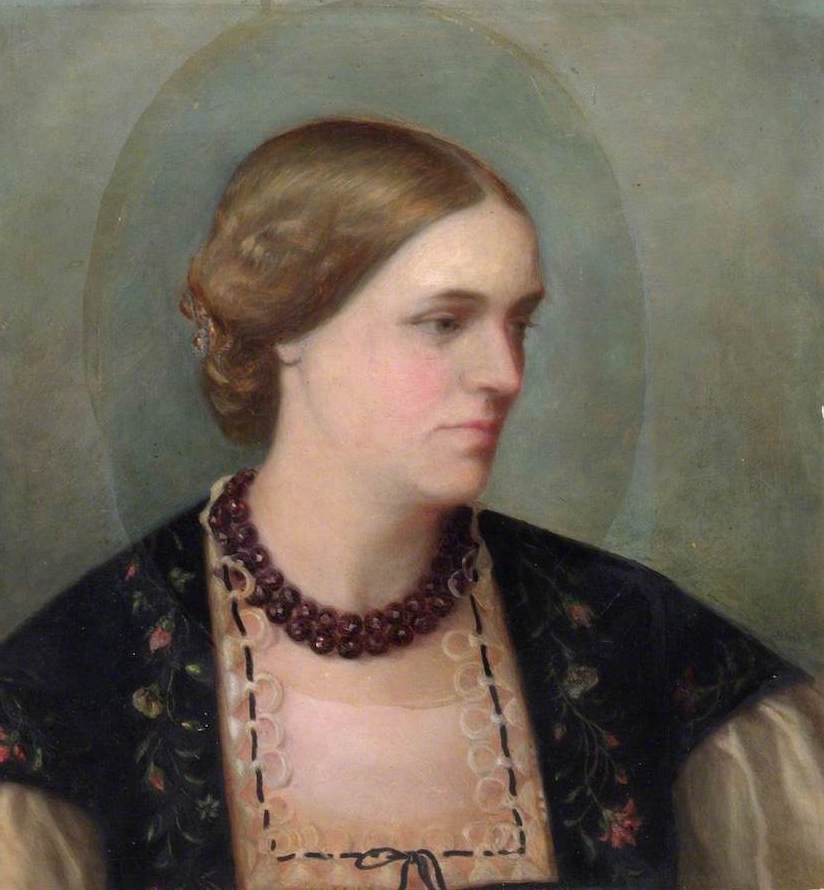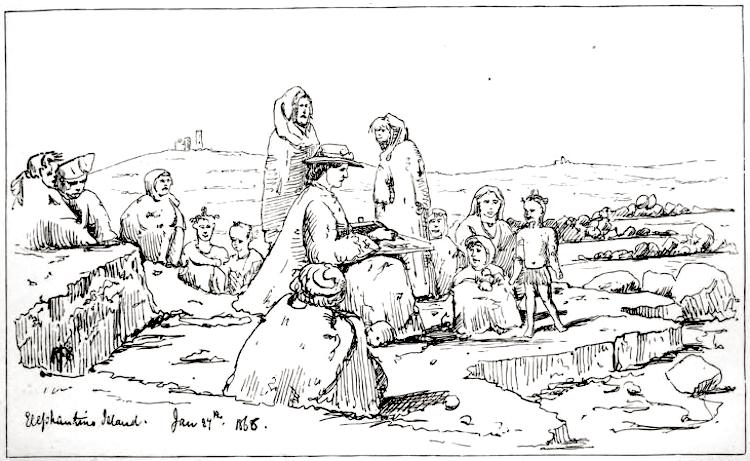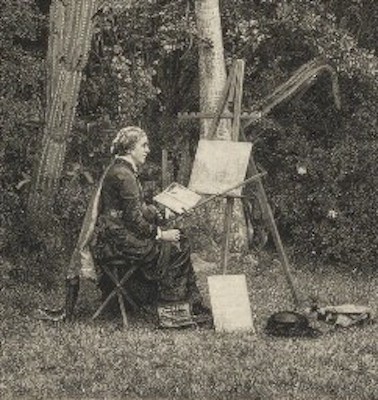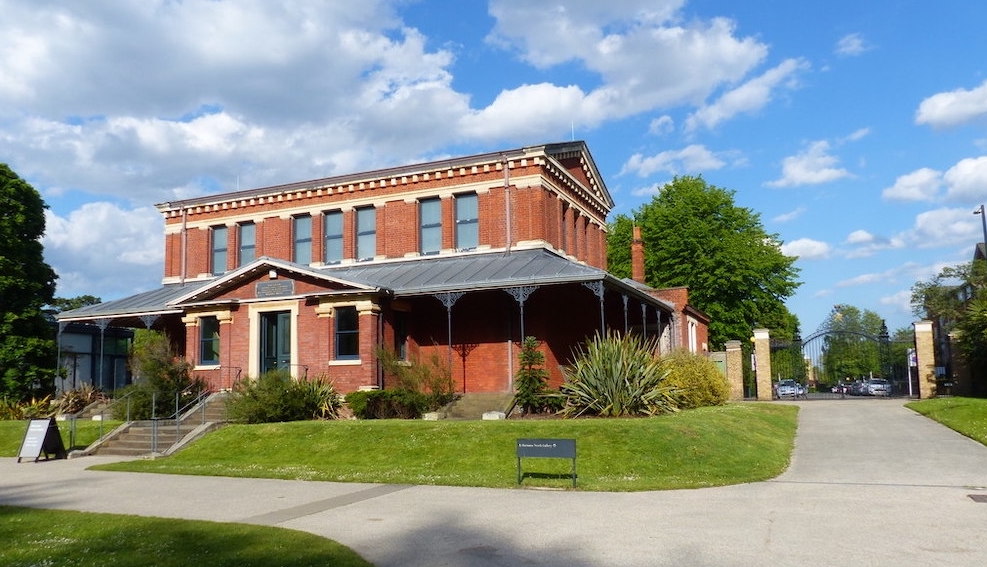[This document comes from Helena Wojtczak's English Social History: Women of Nineteenth-Century Hastings and St.Leonards. An Illustrated Historical Miscellany, which the author has graciously shared with readers of the Victorian Web. The images have been taken from other sources, as specified, and a note and bibliography have been added. Click on the title to obtain the original site, which has additional information.]

Portrait of Marianne North by Mary Anne Hall, Photo credit: The Board of Trustees of the Royal Botanic Gardens, Kew, reproduced on the Creative Commons Attribution-NonCommercial licence (CC BY-NC).
Marianne North was born in 1830 at Hastings Lodge, on the corner of Ashburnham Road and Old London Road (a convent now occupies the site). although a childhood acquaintance of fellow painter Barbara Bodichon she never became involved with the women's emancipation movement. Indeed she was in no need of personal assistance, for her father was a wealthy magistrate and seven times M.P. for Hastings. Marianne lived in luxury and received a large inheritance, which she kept by remaining unmarried.
The 1851 Census shows Marianne (20), her sister (13), their parents, a governess and five other servants living in Hastings Lodge. The family was one of the most prestigious in town, and was related to Countess Waldegrave. Marianne was trained to sing, but she loved to paint and showed great talent. Such activities were acceptable for women only as hobbies and "accomplishments" and it was thought unseemly for a woman of her class to aspire to a profession. Her sister was also talented at painting but she married and, if she continued to paint, her work never reached the public domain.

R. Phené Spiers, "A Friendly Audience" from Some Further Recollections of a Happy Life, facing p.133.
After Mrs North died in 1855, Marianne and her father let their house during the summer and travelled extensively together. When he became ill in 1869 she brought him home to Hastings where he died. Marianne was heartbroken. Two years later, with a large inheritance and as mistress of her own destiny, she forsook Hastings upper-class society and decided to travel the world painting plants and flowers.
In 1871, aged 41, she sold Hastings Lodge and undertook her first great trip, covering North America, Jamaica and Brazil. A further trip in 1875 started in the Americas and then went on to Japan, the East Indies, Ceylon, Australia, New Zealand and South Africa.


Left: A rare photograph of Marianne North at her easel painting exotic plants, cropped from a larger one, courtesy of the National Portrait Gallery, London, on the Attribution-NonCommercial-NoDerivs 3.0 Unported (CC BY-NC-ND 3.0) licence. Right: Pendulous Sparaxis and Long-Tailed Finch in Van Staaden's Kloof, c. 1882.
In Brazil she did most of her work in a hut in the jungle. In 1875, after a few months at Tenerife, she began a two-year journey around the world, painting flowers in California, Japan, Borneo, Java, and Ceylon. She spent 1878 in India. On her return to England, she exhibited a large number of paintings and offered them to Kew Botanical Gardens.

Photograph of the Marianne North Gallery, Kew, by Ruth Sharville, available on the Creative Commons Attribution-ShareAlike 2.0 Generic Licence.
Among Marianne's acquaintances and friends were Edward Lear, U.S. President Grant, and Charles Darwin. At the latter's suggestion she went to Australia in 1880 and then to New Zealand. Between 1883 to 1885 she worked in South Africa, the Seychelles and Chile. She continued to travel until the mid-1880s despite poor health. Her journal relates scaling cliffs and crossing swamps to reach the plants she wanted, with little regard for danger. She mentions breakdowns and bad weather in passing, but usually follows this with a description of the flowers and plants she drew while waiting for it to pass. On her return to England in 1885 she lived in Gloucestershire, where she died in 1890.
Marianne North had one genus and four species named after her. Four of them were first recorded by her:
- Northea seychellana (a tree in the Seychelles, a previously unreported genus)
- Nepenthes northiana (the large pitcher plant of Borneo, first painted by her)
- Crinum northianum (one of the Amaryllis relatives)
- Areca northiana (one of the feather palms)
- Kniphofia northiana (one of the African torch lilies or poker plants)
Her work is of great botanical importance because she depicted nature as she saw it.
She completed 848 paintings in 13 years, of which 832 were given to Kew Gardens in 1882, and she paid for a gallery in which to display them. She supervised the architect and herself painted the frieze and decorations around the doors. The gallery is unusual because it contains almost the entire work of one artist. It is still one of the popular attractions of Kew Garden, and the paintings remain in their original Victorian arrangement.
Note
Despite her pioneering work and travels, North was in some important ways very much of her time. As Maura O'Connor says, visitors going round the gallery are bound to feel impressed by its very methodical organisation, and its scope: "One large room displays records of her journeys through botanical representations and picturesque scenes of daily life in Australia, New Zealand, Java, Japan, Borneo, Singapore, India, Ceylon, America, Jamaica, Brazil, and Chile. The innermost part of the gallery continues to record her journeys through the Cape of Good Hope, South Africa, and the Seychelles Islands"; but these same visitors might also notice that her depictions of the indigenous peoples of these strikingly different countries are "simplistic and, not surprisingly, picturesque. The gallery," O'Connor concludes, "reflects her fondness for plants and exotic fauna and her lack of attention to the world’s peoples and their diverse cultures" (255).
It is certainly true that North took advantage of her contacts, for example with Sir Joseph Hooker, and that, consciously or unconsciously, she shared and even helped to foster the imperial mindset. One might add, however, that she often had little time for her own compatriots in these far-flung places. Her focus was entirely on her art, her single-minded mission to paint the flora and often fauna of the countries she visited. Curious bystanders could be a hindrance to this mission, although she treated even those who encroached on her working space with reasonably good humour — once, in Java, dabbing blue on a boy's nose when he came too close, to the entertainment of all (Recollections I: 295). — Jacqueline Banerjee
Link to Related Material
Bibliography
Dowe, John Leslie. “Marianne North’s Paintings of Australian Gardens, 1880–81.” Australian Garden History 30, no. 1 (2018): 12–15. https://www.jstor.org/stable/26780344.
Hooker, Joseph D. Preface. The Gallery of Marianne North's Paintings of Plants and Their Homes, Royal Gardens. Kew. Descriptive Catalogue Designed by W. Botting Helmsley, ALS. London: 1882. v-vi. Google Books. Free to read.
Huxley, Anthony. Introduction. A Vision of Eden: The Life and Work of Marianne North. New York: Holt, Rinehart and Winston, 1980. 9-13.
Lambourne, Lionel. Victorian Painting. London and New York: Phaidon, 1999.
Lyons, Nancy. "Marianne North in India: travels of a pioneering Victorian artist." Art UK. Web. 27 August 2023.
McHale, Ellen. "Things You Should Know about Marianne North." website">Royal Botanical Gardens, Kew. Web: https://www.kew.org/read-and-watch/marianne-north-botanical-artist. 26 August 2023.
Middleton, Dorothy. Victorian Lady Travellers. New York: Dutton, 1965.
North, Marianne. Recollections of a Happy Life: being the autobiography of Marianne North. Vol. I. London and New York, Macmillan, 1893. Internet Archive, from a copy of a book in the Wellcome Library. Web. 26 August 2023.
_____. Recollections of a Happy Life: being the autobiography of Marianne North. Vol. II. London and New York, Macmillan, 1893. Internet Archive, from a copy of a book in the Wellcome Library. Web. 26 August 2023.
_____. Some Further Selected from the Journals of Marianne North, chiefly between the years 1859 and 1869. Ed. Mrs John Addington Symonds. London and New York, Macmillan, 1893. Internet Archive, from a copy of a book in the Robarts Library, University of Toronto. Web. 26 August 2023.
O'Connor, Maura. "Marianne North." British Travel Writers, 1876-1909. Ed. Barbara Brothers and Julia Marie Gergits. Detroit: Gale Research, 1997. 251-55.
Roy, Malini. " Marianne North's Visions of India." British Library. Web. 26 August 2023.
Created 18 May 2007
,br/>Last modified 4 September 2023